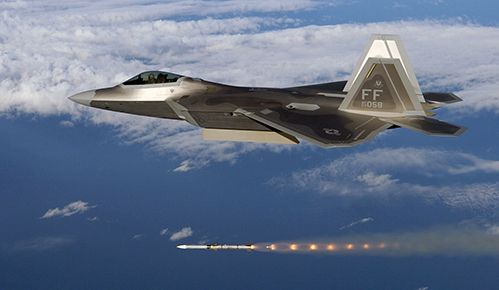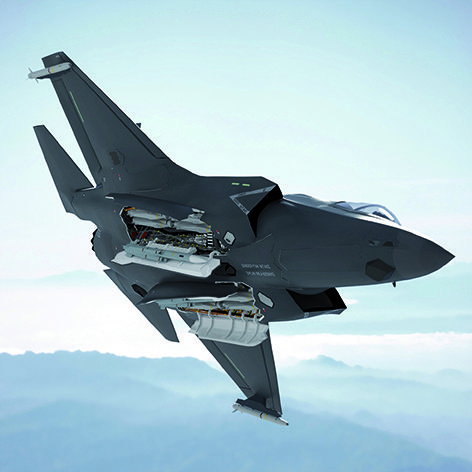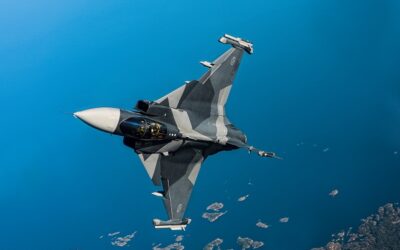Overview of air-to-air missiles
Air-to-air missiles (AAM) are the primary armament for fighter aircraft today, and the gun has largely fallen out of favour, though it remains useful in some circumstances, when rules of engagement dictate, or when other weapons are electronically jammed or blinded by laser. AAMs are generally divided into two broad categories – short range AAMs (SRAAMs) for use against targets that are within visual range (WVR), and longer-range BVRAAMs (Beyond Visual Range AAMs).
WVR missiles are usually ‘heat-seeking’, homing on a target’s IR signature – usually from the jet pipe, but sometime also from the wing leading edge of supersonic targets. The earliest IR-homing missiles had to be fired from directly behind a target, but as the sensitivity of seekers has improved, many can now be fired from all aspects. The combination of focal plane imaging infrared (IIR) sensors and advanced processing in the latest SRAAMs make them more accurate and harder to decoy, and (together with proximity fusing) allow the missile to be detonated adjacent to the most vulnerable part of a target (usually the cockpit) rather than homing all the way into the jetpipe. With previous generations of IR-homing missiles, many aircraft have limped home with damaged jet pipes and a tail peppered with shrapnel, whereas aimpoint selection makes a kill much more certain.
Most modern short-range air-to-air missiles now use IIR seekers, though the Russian R-73 still relies on a simple infrared (IR) seeker.
Missiles can now be cued and locked on using helmet-mounted sighting (HMS) systems, meaning that the pilot does not have to manoeuvre to place his target ‘dead ahead’, but can instead fire at targets far off his ‘boresight’. Many modern SRAAMs feature thrust-vectoring rocket motors, giving a massive improvement in missile manoeuvrability that makes them much harder to defeat.
The AIM-9X is the latest member of the AIM-9 SIDEWINDER family. It has a distinctly different aerodynamic configuration compared to earlier SIDEWINDERs, which relied on moving canard foreplanes and rollerons on the tail fins for control. The AIM-9X has smaller fixed forward fins and cropped tailfins that lack rollerons, and instead has moving paddles that vector the thrust of the rocket motor. The smaller fins reduce drag and allow internal carriage by the F-22 RAPTOR and the Joint Strike Fighter.
The AIM-9X uses the same Raytheon-developed IIR seeker as the MBDA AIM-132 ASRAAM, which gives a 180° field of view and a useful lock-on-after-launch capability, while the weapon is well integrated with the JHMCS HMS.
With a massive production run for the US forces, a long lineage, and a large number of test-firings, the AIM-9X is a dependable weapon. A Block II (X-2) version, with improvements to the fuze and other components, entered service in 2009. Though Block III development has stalled, the US is developing two future short-range weapons – the small advanced capabilities missile (SACM) and the miniature self-defence munition (MSDM).
Diehl Defence’s IRIS-T was designed to counter the Russian R-73 ARCHER, and to be very agile. The missile is compatible with SIDEWINDER launchers and targeting systems, but featured a new, lower drag aerodynamic configuration with exceptionally broad-chord wings and relatively small tailfins. Like the AIM-9X, it features thrust vectoring, but also embodies Ku-band fuzing (the AIM-9X uses a laser fuze). The IRIS-T uses a two-colour scanning seeker similar to that used on the MBDA MICA IR weapon. BGT claims that scanning arrays are less susceptible to directed IR countermeasures (DIRCM) than staring arrays.
On 14 June, Diehl Defence signed another contract for the supply of short range air-air missiles IRIS-T (InfraRed Imaging System – Tail/Thrust Vector Controlled) to Thailand, continuing the successful cooperation of recent years.
As early as 2011, the Royal Thai Air Force (RTAF) had selected the European short-range missile for arming their GRIPEN and F-16 fighters. In addition, the new procurement plans to integrate the missile into the F-5 fleet.
With its exceptional performance features, IRIS-T is one of the world´s most advanced short-range air-to-air missiles. In addition to defeat enemy fighter aircraft, self defence capability against attacking air-to-air or ground-to-air missiles is provided. Even attacks from the rear can successfully be defeated without having to change course.
IRIS-T was developed and procured by Germany, Greece, Italy, Norway, Spain and Sweden as successor of the aging SIDEWINDER missiles. The series production started in 2005. Other user states today include Austria, Saudi Arabia, South Africa and, case in point, Thailand.
As a multi-purpose weapon, IRIS-T is also used as a surface-to-air missile in a ground-based air defence role.
Advanced Seekers
The MBDA AIM-132 ASRAAM was designed to a different philosophy compared with the AIM-9X and IRIS-T, with marginally less agility at very close range but with lower drag and a significantly longer range (giving a significant beyond-visual range capability) and a much larger ‘no-escape zone’. ASRAAM was the first SRAAM with an advanced IIR seeker head – a seeker subsequently adopted for the AIM-9X. MBDA’s MICA is a similarly long-range weapon, and is unique among Western missiles, being available in both IR- and radar-guided variants (the MICA IR and MICA RF). It was also the first Western air-to-air missile to use thrust vectoring and the first operational missile to demonstrate an over-the-shoulder shot.
Rafael’s PYTHON 5 is the latest variant in the Israeli short-range AAM family and features a dual-band (IR and ultra-violet) seeker head. It uses a conventional SIDEWINDER-like configuration, albeit with fixed canards in front of the moving control fins, and swept tail fins. Though it lacks thrust vectoring, Rafael claims that the missile is as agile as any missile that embodies the feature.
Japan’s Mitsubishi AAM-5 uses a similar configuration to the IRIS-T and MICA, and features a gimballed IR focal plane array multi-element seeker. The missile is used by JASDF F-15J and F-2 fighters. An upgraded version, the AAM-5B, offers longer range and increased resistance to infra-red countermeasures.
The V-3E A-DARTER, developed by Denel Dynamics (formerly Kentron) and Mectron, Avibras and Opto Eletrônica, is a virtually smokeless thrust-vectoring SRAAM, which can be cued via a helmet sight, and that has lock on after launch and over the shoulder capabilities. Some have claimed superiority over the IRIS-T in some key respects.
The MAA-1B PIRANHA is a fourth-generation air-to-air missile produced by Brazil’s Mectron under a joint venture programme with Airbus Defence & Space, and is a derivative of the original PIRANHA.
Russia’s standard short-range missile was the Vympel R-73 AA-11 ARCHER, now being replaced by the similar R-74M, which features a new two-band IR seeker that increases off-boresight and range performance. The weapon is cued by the Schmel HMS.
China’s existing in-service PL-8 and PL-9 SRAAMs are closely based on the PYTHON 3 and AIM-9M respectively, but the newer PL-10 appears to be an all-new design. The PL-10 uses the broad-chord narrow-span wing and TVC configuration that has become common for modern IR AAMs, including the IRIS-T and MICA. The missile is equipped with an IIR seeker capable of engaging targets at high off-boresight angles, and is believed to have datalink connectivity to give a lock on after launch capability.
Next Generation of BVR Missiles
Though weapons like the ASRAAM and MICA MICA a significant long range reach, they were never intended to be primarily for BVR use.
Early BVR missiles were beam-riders, or used semi-active radar homing (SARH). These kinds of weapon required the launch aircraft to keep the target illuminated throughout the missile’s flight time and limited it to supporting a single missile in flight. This meant keeping the fighter’s radar pointed at the target, limiting the launch aircraft’s ability to manoeuvre, resulting in closure in a head on engagement, and increasing the risk of a return missile shot.
The next generation of BVR missiles tended to have an active radar for terminal homing, and a notional ‘fire and forget’ capability using inertial mid-course guidance. A launch aircraft could also launch and support several missiles simultaneously. But, in reality, the target might well not be where it was predicted to be when the missile was launched and the missile’s active radar, scanning a small cone of sky, might not find it. Therefore, these missiles tend to require mid-course updates from the launch aircraft, updating the target position, and only becoming truly autonomous when the missile’s onboard radar locks on to the target.
The AIM-120 AMRAAM entered service in 1991, and dominated BVR air combat for the next two decades. The AMRAAM has been progressively updated, resulting in a succession of improved variants, including the AIM-120C with smaller clipped fins to allow internal carriage by the USAF F-22 RAPTOR, the AIM-120C-6 with an improved fuse and the AIM-120C-7 with improved homing and longer range.

The AIM-120D is the latest, further upgraded version of the AMRAAM, featuring 50% greater range than the already-extended range AIM-120C-7 and an inertial navigation system (INS) augmented with embedded GPS. The missile also incorporates a new datalink. The AIM-120D still relies on a mechanically-scanned X-band active radar seeker, though this has been improved and has a better ability to detect off-boresight targets. With a range of about 160km – details are classified – the AIM-120D has a longer reach and better kill probability than previous AMRAAMs, but may not be a match for the rival MBDA METEOR. More seriously, some worry that it may be grossly outranged by new Chinese and Russian air-to-air weapons, and a replacement is being sought.
The Next Generation Missile (formerly the Joint Dual Role Air Dominance Missile – JDRADM), was a proposed AMRAAM and AGM-88 HARM replacement cancelled in 2013. A parallel project, the T-3 (Triple Target Terminator) programme, continued aiming to produce a weapon for use against enemy aircraft, cruise missiles and air defence networks. More recently, funding for a new Long Range Engagement Weapon has been allocated as part of an ‘emerging capabilities technology development’ effort.
The MBDA METEOR was designed to meet a multi-national European requirement for a next generation BVR missile with superior range and kinematic performance to the American AIM-120.
METEOR uses a solid fuel, variable flow rocket that can be throttled back to save fuel for the final attack phase, giving more energy to manoeuvre during the endgame. This gives the METEOR a much larger no-escape zone and a greater ability to chase and defeat a manoeuvring target.
METEOR is able to get mid-course guidance updates not just from the launch aircraft, but from third party aircraft such as other fighters, or airborne early warning and control (AEW&C) platforms. The pilot of the launch aircraft may never have to use his own radar, firing on the basis of targeting information provided by third parties.
Rafael’s DERBY entered service in 1998 and is broadly equivalent to the initial AIM-120A. The upgraded I-DERBY ER missile was unveiled at the Paris Air Show 2015 and features a solid-state active radar seeker and a dual-pulse rocket motor, giving an operational range of up to 100 kilometres. The status of an air-to-air version of the STUNNER surface-to-air missile, which features a dual mode seeker in a unique ‘dolphin’ nose, is uncertain.
India’s ASTRA Mk.1 is now in limited series production and has been integrated with the Indian Air Force’s Sukhoi Su-30MKI fighters. MIRAGE 2000 and MiG-29 integration is expected to follow. The Defence Research & Development Organisation (DRDO) plans to develop a Mk 2 version with longer range and a larger engagement envelope.
Russia’s primary BVRAAMs are the R-27 (AA-10 ALAMO) and R-77 (AA-12 ADDER, sometimes dubbed AMRAAMSki). The R-27 is available in IR-guided and SARH versions, and there are extended range variants of both. They allow aircraft like the Su-27 and MiG-29 to fire pairs of IR- and SARH missiles to maximise kill probability. The newer R-77 has active radar homing and is broadly equivalent to AMRAAM.
The R-33 (AA-9 AMOS) and R-37 (AA-X-13/AA-13 ARROW) are long-range air-to-air missiles (with ranges of 160km and 300km respectively) carried by the MiG-31 FOXHOUND, and of similar configuration to the US AIM-54 PHOENIX, as used by the F-14 TOMCAT.
Russian development programmes include the Novator KS-172, a very long-range weapon primarily intended to engage US AEW, ISR and tanker aircraft far behind the frontline. The KS-172 is believed to form the basis of the Indian K100 missile.
China’s most advanced in-service BVRAAM is the PL-12, which is broadly comparable to the AIM-120C4. It is believed to use a derivative of the Russian Agat 9B-1348E seeker, as used in the R-77. The PL-15 is a redesigned variant with cropped aerosurfaces to allow it to fit into the internal weapons bays of the J-20 and J-31. Development programmes include the PL-X – a very large, very long-range missile seen carried by a J-11B during the 2016 Red Sword exercise, and believed to be intended as an AWACs killer.
Jon Lake is a senior aerospace expert and a regular contributor to MT.

























